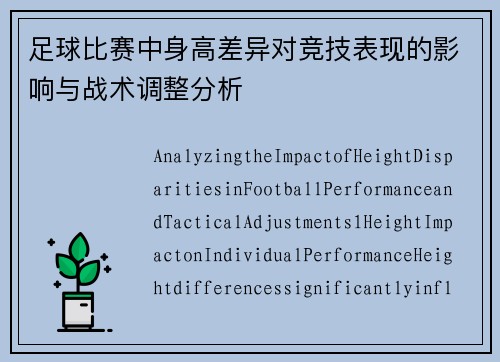足球比赛中身高差异对竞技表现的影响与战术调整分析
Analyzing the Impact of Height Disparities in Football Performance and Tactical Adjustments
九游体育1、Height Impact on Individual Performance
Height differences significantly influence player performance in football, affecting aerial duels, reach, and physical dominance. Taller players often excel in defensive headers, while shorter players exhibit agility advantages in tight spaces.

Moreover, height impacts a player's ability to cover ground efficiently, influencing their role in pressing or counter-attacking strategies. Teams adapt by deploying taller players in central defense or set-piece situations to capitalize on their aerial prowess.
In contrast, shorter players are strategically positioned in midfield or forward roles to exploit speed and technical skills, creating mismatches against taller, less agile defenders.
2、Tactical Adjustments in Set Pieces
Set-piece strategies in football heavily rely on height differentials for both defensive solidity and attacking potency. Teams with taller players utilize zonal marking to neutralize opponents' aerial threats, focusing on defensive positioning and timing.
Conversely, teams lacking height prioritize quick transitions and compact defenses to minimize set-piece vulnerabilities. Offensively, they employ intricate movements and low crosses to bypass tall defenders and create scoring opportunities.
Coaches adjust tactics based on their squad's height profile, emphasizing defensive organization or offensive creativity to exploit opponents' weaknesses.
3、Role of Height in Goalkeeper Performance
Height significantly influences goalkeeper performance, affecting shot-stopping ability and command of the penalty area. Taller goalkeepers leverage reach to cover more space and dominate aerial crosses, enhancing defensive stability.
Shorter goalkeepers compensate with agility and reflexes, excelling in one-on-one situations and quick reactions to close-range shots. Tactical adjustments involve defensive strategies that complement the goalkeeper's strengths, such as compact defending or aggressive pressing.
Teams strategically choose goalkeepers based on opponents' attacking styles, balancing height advantages with technical skills to optimize defensive capabilities.
4、Psychological and Strategic Adaptations
Height differentials also influence psychological dynamics within teams, impacting confidence levels and strategic decision-making. Taller players may possess a psychological edge in physical confrontations, influencing opponents' tactical adjustments and defensive strategies.
Teams cultivate a cohesive mentality regardless of height differentials, emphasizing collective strengths and adaptive strategies to overcome physical disadvantages. Coaches integrate psychological training to enhance team unity and resilience, fostering a competitive edge.
In conclusion, height disparities in football necessitate strategic flexibility and psychological resilience, shaping tactical innovations and team dynamics.
Overall, understanding these influences enhances tactical preparedness and fosters a competitive advantage in football.
